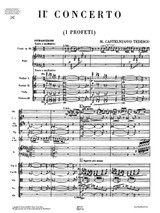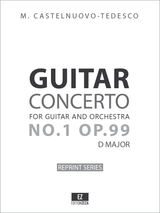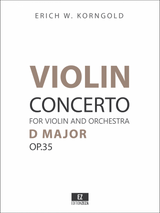Among Castelnuovo-Tedesco’s important, large-scale Judaically incited concert works is his second violin concerto (Op. 66), which he subtitled I profeti (The Prophets). Its three movements are further subtitled with reference to two biblical prophets: Isaiah, for the first movement—marked “Grave e meditative,” and Jeremiah, for the second—marked “Espressivo e dolente”; and, for the third and final movement—marked “Fiero e impetuoso (ma sustenuto e ben marcato il ritmo)”—Elijah, known as Elijah the Prophet, who, based on Malachi 3:23 (the end of the Prophets), will, at a time of the Creator’s choosing, herald the era of ultimate redemption and the coming of the Messiah. This is not a programmatic piece in the sense of any story line or specific events being depicted by the music, but Castelnuovo-Tedesco drew his inspiration from those two biblical books and personalities (Isaiah and Jeremiah) and from the historical as well as theological ramifications of Elijah. The concerto reflects the composer’s interpretations of the related moods and tones of admonition, teaching, and prediction associated with these prophetic sources. In that overall context, his aim was to suggest musically “the flaming eloquence of the ancient prophets among the surrounding voices of the people and voices of nature,” and thereby to evoke a general aura of perceived “Hebraic flavor”—which is noticeable at the outset of the first movement in the echo of a biblical cantillation motif of the initial three-note motive upon which the movement is built.
The second movement begins with a passage for unaccompanied solo violin mirroring the character of a Hebraic liturgical chant or incantation, which is treated contrapuntally and imaginatively developed throughout the movement. The introductory passage of the third movement hints at pentatonic modality, which proceeds quickly to fanfare fragments. Those two recurring elements are developed throughout the movement, which, in its overarching, jubilant march rhythms, suggests the traditional messianic associations with Elijah.
None of the melodic material is specifically Sephardi, except for the possible connection between the principal motive of the first movement to Sephardi biblical cantillation motifs. But, like most of Castelnuovo-Tedesco’s Judaically related concert works—as well, of course, as his liturgical pieces—this concerto was inspired not only by his openly voiced Jewish identity but by his proudly proclaimed Sephardi heritage.
Castelnuovo-Tedesco composed I profeti expressly for Jascha Heifetz, who gave it its world premiere in 1933 at Carnegie Hall in New York, with the New York Philharmonic conducted by Arturo Toscanini.
- Difficulty:
- Advanced
- Instrumentation:
- 2Fl, 2Ob, EH, 2Cl, 2Bsn, 4Hn, 3Tpt, 3Tbn, Timp, Perc, Pno, Harp, Solo Vln, Strings
- Duration:
- 30 minutes
- Set of Parts:
- Includes Strings count 4.4.3.3.2
- Extra Strings:
- Only available with the purchase of the Set of Parts







